
The Polish 1st Armoured Division was an armoured division of the Polish Armed Forces in the West during World War II. Created in February 1942 at Duns in Scotland, it was commanded by Major General Stanisław Maczek and at its peak numbered approximately 18,000 soldiers. The division served in the final phases of the Battle of Normandy in August 1944 during Operation Totalize and the Battle of Chambois and then continued to fight throughout the campaign in Northern Europe, mainly as part of the First Canadian Army.

The Upper Silesia plebiscite was a plebiscite mandated by the Versailles Treaty and carried out on 20 March 1921 to determine ownership of the province of Upper Silesia between Weimar Germany and Poland. The region was ethnically mixed with both Germans and Poles; according to prewar statistics, ethnic Poles formed 60 percent of the population. Under the previous rule by the German Empire, Poles claimed they had faced discrimination, making them effectively second class citizens. The period of the plebiscite campaign and inter-Allied occupation was marked by violence. There were three Polish uprisings, and German volunteer paramilitary units came to the region as well.
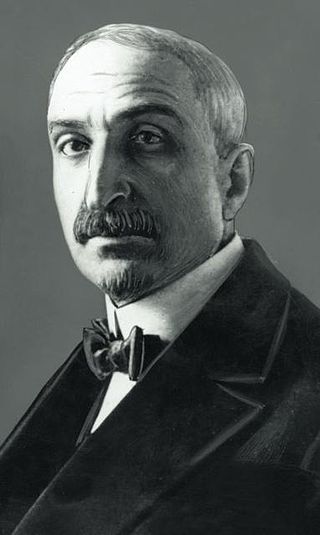
Szymon Askenazy was a Jewish-Polish historian, educator, statesman and diplomat, founder of the Askenazy school.

Zygmunt Wojciechowski was a Polish historian and nationalist politician. Born in 1900 in then-Austria, he obtained a doctorate from medieval history at Lviv University. In 1925 he moved to Poznań, where he became a full professor in 1929. In 1934-1939 he became politically involved with the nationalist party Endecja. During occupation of Poland by Nazi Germany he worked in Polish underground opposing German genocide of Poles by providing underground teaching, which was banned by German state and worked on future concept of Polish borders that would provide Poland with safety against any further German aggression. He supported an alliance with Soviet Union and after the war he continued to work as historian in People's Republic of Poland and headed Western Institute that studied former Polish territories recovered from Germany and history of Polish-German relations. He was a recipient of Commander's Cross and Officer's Cross of Order of Polonia Restituta.
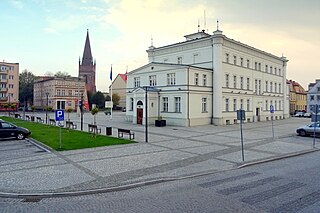
Skwierzyna is a town of 9,671 inhabitants (2019) in Lubusz Voivodeship in western Poland, the administrative seat of the Gmina Skwierzyna. It is located at the confluence of the Obra and Warta rivers, about 18 km (11 mi) north of Międzyrzecz and 23 km (14 mi) south-east of the regional capital Gorzów Wielkopolski. The town is situated in a particularly green part of Poland. Extensive forests and numerous lakes can be found in the vicinity.

Poles in Germany are the second largest Polish diaspora (Polonia) in the world and the biggest in Europe. Estimates of the number of Poles living in Germany vary from 2 million to about 3 million people living that might be of Polish descent. Their number has quickly decreased over the years, and according to the latest census, there are approximately 866.690 Poles in Germany. The main Polonia organisations in Germany are the Union of Poles in Germany and Congress of Polonia in Germany. Polish surnames are relatively common in Germany, especially in the Ruhr area.

Displaced persons camps in post–World War II Europe were established in Germany, Austria, and Italy, primarily for refugees from Eastern Europe and for the former inmates of the Nazi German concentration camps. A "displaced persons camp" is a temporary facility for displaced persons, whether refugees or internally displaced persons. Two years after the end of World War II in Europe, some 850,000 people lived in displaced persons camps across Europe, among them Armenians, Poles, Latvians, Lithuanians, Estonians, Yugoslavs, Jews, Greeks, Russians, Ukrainians, Hungarians, Czechoslovaks and Belarusians.

The entirety of Germany was militarily occupied by the Allies from the Berlin Declaration on 5 June 1945 to the establishment of West Germany on 23 May 1949. After Nazi Germany (1933–1945) of the German Reich (1871–1945) surrendered to the Allies and collapsed on 8 May 1945, the four countries representing the Allies asserted joint authority and sovereignty with the Allied Control Council (ACC) at the 1945 Berlin Declaration. At first, defining Allied-occupied Germany as all territories (1922–1938) of the former German Reich before the Nazi annexing of Austria and later at the 1945 Potsdam Conference of the Allies themselves, the Potsdam Agreement on 1 August decided the new eastern German border by giving Poland and the Soviet Union all regions of Germany east of the Oder–Neisse line and divided the remaining "Germany as a whole" into the four occupation zones for administrative purposes under the United States, the United Kingdom, France, and the Soviet Union. Although the three of Allies agreed about the occupation, division, and border of Germany in the 1943 Tehran Conference in Iran before, the four occupied zones located in Germany were only agreed by the three Allies at the February 1945 Yalta Conference.

Bergen-Belsen displaced persons camp was a displaced persons (DP) camp for refugees after World War II, in Lower Saxony in northwestern Germany, southwest of the town of Bergen near Celle. It was in operation from the summer of 1945 until September 1950. For a time, Belsen DP camp was the largest Jewish DP camp in Germany and the only one in the British occupation zone with an exclusively Jewish population. The camp was under British authority and overseen by the United Nations Relief and Rehabilitation Administration (UNRRA) with camp directors that included Simon Bloomberg. Today, the camp is a Bundeswehr barracks, having been a British Army base until 2015.

Sh'erit ha-Pletah is a Hebrew term for Jewish Holocaust survivors living in Displaced Persons (DP) camps, and the organisations they created to act on their behalf with the Allied authorities. These were active between 27 May 1945 and 1950–51, when the last DP camps closed.

Haren is a town in Lower Saxony, Germany in the district of Emsland.
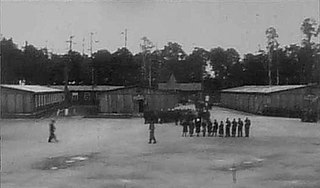
Potulice concentration camp was a concentration camp established and operated by Nazi Germany during World War II in Potulice near Nakło in the territory of occupied Poland. Until the spring of 1941 it was a subcamp of the Stutthof concentration camp. In January 1942 Potulice became fully independent. It is estimated that a total of 25,000 prisoners went through the camp during its operation before the end of 1944. It became notable also as a detention centre for kidnapped Polish children that underwent the Nazi experiment in forced Germanisation.
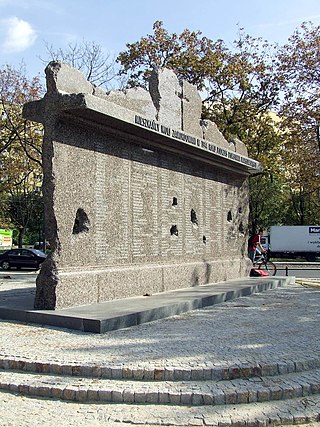
Crimes against the Polish nation committed by Nazi Germany and Axis collaborationist forces during the invasion of Poland, along with auxiliary battalions during the subsequent occupation of Poland in World War II, consisted of the murder of millions of ethnic Poles and the systematic extermination of Jewish Poles. These mass murders were enacted by the Nazis with further plans that were justified by their racial theories, which regarded Poles and other Slavs, as well as Jews, as racially inferior Untermenschen.

The flight and expulsion of Germans from Poland was the largest of a series of flights and expulsions of Germans in Europe during and after World War II. The German population fled or was expelled from all regions which are currently within the territorial boundaries of Poland: including the former eastern territories of Germany annexed by Poland after the war and parts of pre-war Poland; despite acquiring territories from Germany, the Poles themselves were also expelled from the former eastern territories of Poland annexed by the Soviet Union. West German government figures of those evacuated, migrated, or expelled by 1950 totaled 8,030,000. Research by the West German government put the figure of Germans emigrating from Poland from 1951 to 1982 at 894,000; they are also considered expellees under German Federal Expellee Law.
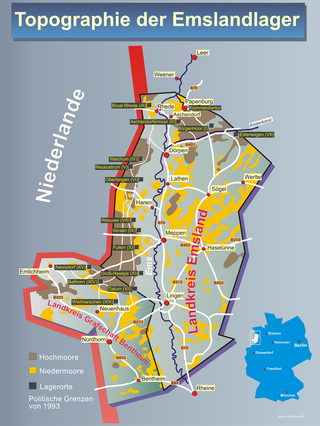
Emslandlager were a series of 15 moorland labor, punitive and POWs-camps, active from 1933 to 1945 and located in the districts of Emsland and Bentheim, Lower Saxony, Germany. The central administration was set in Papenburg where now a memorial of these camps, the Dokumentations- und Informationszentrum (DIZ) Emslandlager, is located.
The 11th Carpathian Infantry Division, was a tactical unit of the Polish Army in the interbellum period, which fought in the Invasion of Poland in 1939. Elements of the unit would go on to serve in the Polish Armed Forces in the East.

The 3rd Polish Infantry Brigade was a Polish infantry brigade which served during World War II. Together with the 10th Armoured Cavalry Brigade they formed part of the 1st Polish Armoured Division and was created from Polish soldiers who had already escaped from Poland to France, and after the fall of France made their way to Great Britain. Their wartime headquarters were in Biggar High School, South Lanarkshire
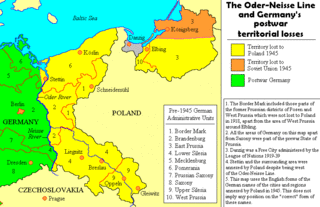
The Oder–Neisse line is the basis of most of the international border between Germany and Poland. It runs mainly along the Oder and Lusatian Neisse rivers and meets the Baltic Sea in the north, just west of the ports of Szczecin and Świnoujście.
After World War II both West Germany and East Germany were obliged to pay war reparations to the Allied governments, according to the Potsdam Conference. Other Axis nations were obliged to pay war reparations according to the Paris Peace Treaties, 1947. Austria was not included in any of these treaties.

The occupation of Poland by Nazi Germany and the Soviet Union during World War II (1939–1945) began with the German-Soviet invasion of Poland in September 1939, and it was formally concluded with the defeat of Germany by the Allies in May 1945. Throughout the entire course of the occupation, the territory of Poland was divided between Nazi Germany and the Soviet Union (USSR), both of which intended to eradicate Poland's culture and subjugate its people. In the summer-autumn of 1941, the lands which were annexed by the Soviets were overrun by Germany in the course of the initially successful German attack on the USSR. After a few years of fighting, the Red Army drove the German forces out of the USSR and crossed into Poland from the rest of Central and Eastern Europe.



















